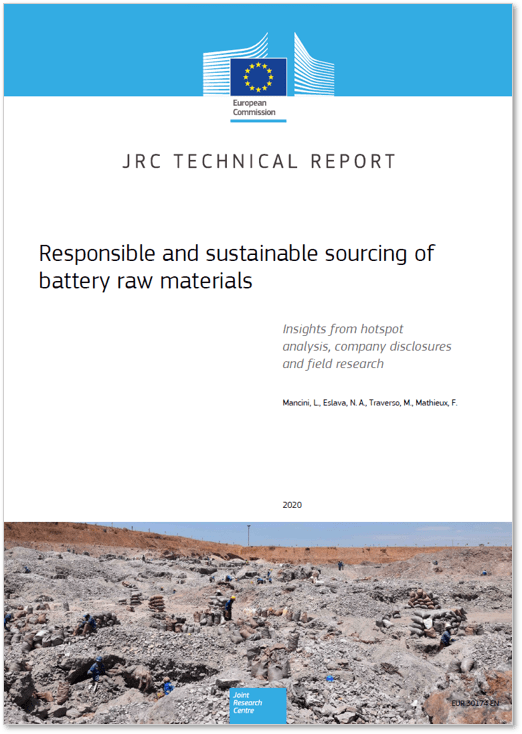
Responsible and sustainable sourcing of battery raw materials (JRC Technical Report)
Used in e-mobility and electronics, batteries are essential to achieve the EU objective of decarbonisation of the economy and other challenges related to sustainable development. Several policy initiatives have been issued and others are under discussion to promote sustainable and competitive production of batteries in the EU.
Recently, various stakeholders highlighted social risks related to supply chains of batteries and in particular in regard to the provision of raw materials. Cobalt is especially concerning when it comes to human rights abuses, child labour and life-threatening working conditions in the Democratic Republic of the Congo (DRC). That country provides around 60 % of the global supply, a significant proportion of it originating from artisanal and small-scale mining (ASM) operators. Reports from non-governmental organisations (NGOs), international organisations and media on this topic have increased in number since 2016, and the issue is now more visible than in 2007, when the first reports on the sector emerged. At the same time, responsible sourcing initiatives have been launched and implemented for cobalt and other materials, most of them aligned with the OECD [Organisation for Economic Co-operation and Development] due diligence guidance for responsible supply chains of minerals from conflict-affected and high-risk areas (OECD Guidance). Among them, EU Regulation 2017/821 will require EU importers of tin, tungsten, tantalum and gold (3TG) to perform due diligence on their supply chain, according to the OECD Guidance. The strategic battery action plan proposed by the European Commission identifies some clear work streams on responsible sourcing. A battery-specific regulation including requirements for the ethical sourcing of materials is also currently under discussion.
The objective of Chapters 2 and 3 is to identify potential risks in the mining stage of battery materials’ production, using data at country and corporate levels. Chapter 2 presents a hotspot analysis of primary raw materials used in batteries. It combines data on the mining stage (including global supply, EU sourcing, and reserves and resources) with indicators considered relevant to the responsible sourcing of batteries (i.e. on governance, conflict risk, human and social rights, environmental performance and water risk). These are complemented by insights from the Environmental Justice Atlas, which documents information about conflicts and struggles over the exploitation of natural resources and the related production processes. The analysis resulted in the identification of three main groups of countries that could present risk as global suppliers, as EU suppliers and for future materials supply.
Chapter 3 investigates what information about social sustainability is available at corporate level. Applying an original methodology, it scrutinises publicly available sustainability reports by large-scale and multinational mining companies that produce materials for batteries, taking into account the impact categories proposed in the social life-cycle assessment (S-LCA) framework and the key principles described by the EU Guidelines for non-financial reporting. Although sustainability reporting practice has been increasing in recent years, the level of disclosure is very heterogeneous between companies and only a few sustainability reports are audited by third-party organisations.
Chapters 4 and 5 focus on the initiatives implemented to mitigate the risks identified in the previous chapters, using both data from the literature and primary data. As companies are increasingly asked to perform due diligence on their supply chains, several initiatives, schemes and company strategies have been developed. They are reviewed in Chapter 4, which compares the different requirements and risk categories that have to be scrutinised under the various initiatives. Most of them are aligned with the requirements of the OECD Guidance, while approaches towards artisanal mining differ. Four initiatives are implemented on the upstream phase, and three of those engage with the ASM sector and work on the ground in order to improve working conditions in the DRC. The impacts of two initiatives (those implemented for at least 1 year) are assessed through a field investigation.
The analysis in Chapter 5 is based on a comparison of two visited pilot projects with the general conditions of the cobalt and copper ASM sector in Lualaba and Haut-Katanga provinces in the DRC. The characterisation of pilot sites is based on the collecting of qualitative information through information matrices. These are based on the OECD Guidance and other relevant standards for responsible and sustainable supply, which include the S-LCA framework. This information gathering was complemented by a visit to a third ASM site, where no pilot was implemented. It was chosen as representative of the general ASM sector, and used as a baseline. Given the nature of this work and the amount of primary data collected, an extensive analysis and detailed description of the contexts under investigation are provided. Results show that the systems analysed are rather effective at implementing the changes that they are designed to implement. This is especially visible when it comes to issues of life-threatening working conditions and child labour. However, risk categories addressed by these projects are dictated by downstream expectations and do not necessarily correspond to the demands of the miners they are designed to protect. For instance, price calculation and income are particularly salient aspects and are not captured by the evaluations. The S-LCA methodology offers a promising avenue to expand the scope of enquiry in a structured manner. Traceability is another key point, as the systems are applied only in small areas of the mining sites. Companies’ participation in the pilots could be used to burnish their reputation as a whole, out of proportion to the contribution of the pilot sites to the companies’ overall supply. Moreover, the scalability of these pilots within a short time frame is unknown, as the availability of local skilled professionals, among other challenges, might be a critical bottleneck. Overall, the positive results of the systems analysed warrants an appeal to further facilitate (e.g. through funding) the development of similar initiatives.
This study is a first step towards the understanding and quantification of the main risks in battery supply chains at mining stage, and the assessment of the impact of current initiatives implemented on the ground. It sets the stage for a more complete understanding of the concept and practice of responsible sourcing, and proposes a methodology that could be replicated for other materials, other sectors and other applications.






Responsible and sustainable sourcing of battery raw materials (JRC Technical Report) 0 reviews
Login to Write Your ReviewThere are no reviews yet.